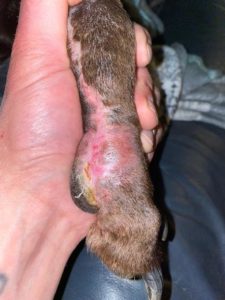We amputate a significant number of toes in our patients.
Did that ever cross your mind?
We’ve performed a huge number of toe amputation, aka digit amputation, both in cats and dogs, and for a variety of reasons.

Indie, an 8 year old Min Pin, had a swollen toe due to a severe infection with a benign bone condition.
When is a toe amputation needed?
There are several common reasons to sacrifice a toe in a pet:
. Benign tumors
. Cancerous tumors
. Severe trauma
. Non-healing wounds
. Non-healed fractures
. Unresolved pain
. Unresolved infection

X-ray of the foot of a 12 year old Lab with cancer in a swollen toe (squamous cell carcinoma).
Which toes can be sacrificed?
This is a really important question, and a tricky one.
Pets only have 4 “useful” toes.
The thumb, or dewclaw, is so short, that it doesn’t do much for a living.
So it can be removed with zero consequences.
That leaves us with 4 toes: inside is #2, then toward the middle #3 and #4, and outside is #5 (the “pinky”).
The outer toes, 2 & 5, do not support weight when a pet walks and runs. They are called non-weight-bearing. So they can be removed with little to no consequences.
The middle digits, 3 & 4, are weight bearing, so they are much more important to walk and run.
Years ago, we didn’t think they could be removed without causing a severe limp.
These days, with more experience, we know they absolutely can be sacrificed.
Some pets, especially on the heavier side, may have a limp.
But typically the limp is mild and these pets can live, play and function normally.
Keep in mind that we don’t remove body parts for fun, it’s always to improve quality and hopefully quantity of life, especially in the case of cancer.
In some rare cases, 2 toes need to be amputated. Even though this is a bit trickier, it can be done (and I have done it). This is called a partial foot amputation, and we still can reach a good outcome.

Rocky, an 8 year old Bulldog, had a benign skin tumor in a toe (collagenous nevus).
What are complications of digit amputation?
Some complications are related to surgery, including limping, soreness, incision problems, infection and delayed healing.
Most complications are related to poor postop care. Licking is a huge no-no.
Because we often protect the surgery site with a splint or a soft bandage, some complications are related to those. They include incision problems, pressure sores, infection and delayed healing.
This is the reason why bandages and splints need to be taken care of very carefully, and why they need to be changed regularly.
What is the outcome of toe amputation?
Even though there may be short-term complications and minor setbacks, the long-term outcome is typically good.
The long-term outcome has less to do with the surgery, and much more to do with the underlying disease.
Because some pictures can be considered disturbing to some sensitive readers, I will include a few pre and postop pictures, with captions, under my signature.
Scroll down at your own risk…
Don’t even look if you are a sensitive soul.
Bottom line: as scary as it sounds, most cats and dogs do well after a toe amputation.
If you would like to learn how we can help your pet with safe surgery and anesthesia, please contact us through www.HRVSS.com
Phil Zeltzman, DVM, DACVS, CVJ, Fear Free Certified

Rocky, an 8 year old Bulldog, had an amputation of the 5th digit because of a benign skin tumor (collagenous nevus).

Teddy, an 11 year old Manx cat, had a severe and unusual infection in a toe due to a fungus called Cryptococcus.

Paige, a 2 year old Aussie, had a benign tumor (fibrolipoma) in the fat pad of the 2rd digit.

Paige postop. Paige’s foot looks pretty cosmetic in spite of her toe amputation.

Paige postop. Paige’s foot looks pretty cosmetic in spite of her toe amputation.

Ellie, an 11 year old Lab, had 2 toes removed because of an aggressive cancerous tumor in a toe (mast cell tumor grade 3). Her foot still looked pretty cosmetic.

